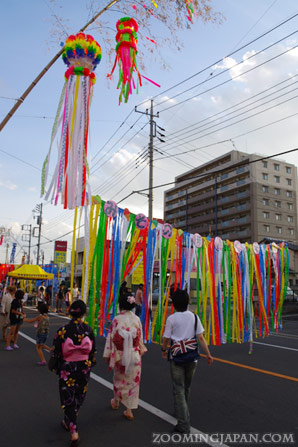Today is July 7th in Japan and that’s when the calendar tells us it’s “Tanabata” (七夕) which is also known as “The Star Festival” (星祭, hoshi matsuri). It was one of the “five seasonal festivals” (五節句, gosekku) established by the Tokugawa Shogunate.


What is the Tanabata Festival?
If you translate Tanabata it means the “evening of the 7th”. It refers to the 7th day of the 7th month which in modern times translates to July 7th.
However, some regions of Japan still celebrate “Tanabata” in August as that’s when the festival was held based on the formerly used lunar calendar.
One example is the “Tanabata Festival” in Tatebayashi (Gunma Prefecture). That’s where all the photos in this blog post are from. I attended it last year (2012) in August.
There are a lot of famous celebrations such as the “Sendai Tanabata Matsuri” (August 6th-8th). In the Kanto region there’s another famous Tanabata Festival in early July which takes place in Hiratsuka (Kanagawa Prefecture).


What is celebrated?
The origins of the Tanabata Festival go back to the Chinese Qixi Festival aka “The Festival to Plead for Skills” (乞巧奠, kikkoden).
I’m sure most of you have heard about the story behind the “Star Festival” and I personally really like it! It is based on a Chinese folktale called “The Weaver Girl and the Cowherd“. Nowadays there are many different versions, but the core of the story is the same.
Summary:
A young woman called “Orihime” (織姫) and a young man named “Hikoboshi” (彦星) fall in love.
However, Orihime’s father is not happy about the relationship. He makes sure both are seperated by the Amanogawa (Heavenly River, 天の川).
Only once a year on the 7th night of the 7th month they are allowed to meet.
It is said that if it rains on Tanabata, they can’t meet and have to wait for another year.
In the story the river represents the Milky Way, Orihime stands for Vega and Hikoboshi for Altair.
You can read one version of the story with cute illustrations here.
The Tanabata Festival celebrates the yearly reunion of the two lovers.

Why is “七夕” read as “Tanabata”?
Those among you who study Japanese might have noticed that “七夕” should be read as “Shichiseki” and you are right.
During Edo Period the Chinese Qixi festival became really popular.
There’s a theory that about the same time there was a Shinto ritual where a miko (shrine maiden) used a special cloth that was woven on a loom called “Tanabata” (棚機). This cloth was used as sacrificial offering to the gods in hope for a good harvest.
This Shinto ritual, Obon celebrations and the Chinese Qixi Festival all took place in August and thus some traditions gradually merged under the name “Tanabata”.

Tanabata Festival Decoration
Nowadays you’ll mainly find colorful paper strips called tanzaku (短冊) on which children write their wishes. Often they’re hanging on bamboo.
On the next morning, the pieces of paper are usually released into the ocean or a river. This is related to the Obon custom of “Toro nagashi” (floating paper lanterns)
Streamers (吹き流し, fukinagashi), representing the strings that Orihime used to weave, are also used as decroation.Above the streamers you can often find so-called Kusudama (くす玉), colorful paper balls.
You can see a lot of different streamers and kusudama in the photos above. The decoration for Tanabata is always very colorful.

Even Google Japan used a Tanabata themed Google Doodle today.
How about you?
Have you heard of Tanabata before?
Do you have a similar celebration in your country? :D









Happy Tanabata! We wrote our wish on tanzaku and hung them on a bamboo branch. Hope they come true. How about you? Did you do anything special this year?
Sounds so nice!
No, not this year. I’ve been insanely busy recently! :(
Oh, I almost forgot. We also ate some special Tanabata edition of Koala no March! Being from Australia – it is my favourite Japanese snack after all :)
Haha, I love these, too!
I didn’t know there was a special Tanabata version. Good to know! :D
This is definitely news to me. Thanks for broadening my knowledge of things Japanese!
You are very welcome.
I always find it interesting to hear how some “Ateji” were born. :D
What a great article! So thorough :shiawase:
I always write some wish on tanzaku but I’ve yet to attend of the local festivals! Ah, maybe that’s why my wishes don’t come true :mukatsuku: Lol
Did you go to any tanabata festivals this year?
Haha! Just keep wishing! :D
Well, I tend to go to those in August, but no plans for this year.
I always make my English students write their wishes in my classes. They always come up with the greatest wishes!
I’ve only really spent time in Western Japan, so all the Tanabata festivals I’ve been to are in July. Maybe someday I’ll have a chance to see the August festivals! :sparkling:
Yes, kids are quite amazing when it comes to wishes! *g*
I hope you can visit a festival or two in August! :D